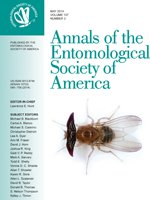The striped stem borer, Chilo suppressalis, is one of the most serious pests of rice, causing extensive damage and yield loss. This report is a study on the expression patterns of three heat shock protein genes of C. suppressalis. Results indicated that hsp90, hsp70, and hsp60 all expressed within eight tissues (organs) sampled from fifth-instar larvae, with the highest levels being found in the hindgut and the lowest levels in the foregut. Interestingly, an abundance of all three hsps were observed in the head. We also examined heat shock protein expression in different life stages and sexes of rice stem borer. The hsp90 and hsp70 also appeared correlated with the developmental processes of C. suppressalis. The results showed that the transcripts of hsp70 varied remarkably in different developmental stages. The hsp60 demonstrated significantly higher expression in female than male adults. All three hsps of C. suppressalis could be induced by temperature stress, especially heat stress. For example, the highest increase for hsp90, hsp70, and hsp60 was at 42, 36, and 36°C, respectively. All three hsps were more sensitive to heat than cold.
How to translate text using browser tools
1 May 2014
Expression Patterns of Three Heat Shock Proteins in Chilo suppressalis (Lepidoptera: Pyralidae)
Ming-Xing Lu,
Zhong-Xian Liu,
Ya-Dong Cui,
Yu-Zhou Du
ACCESS THE FULL ARTICLE
It is not available for individual sale.
This article is only available to subscribers.
It is not available for individual sale.
It is not available for individual sale.
development
Hsp
rice pest
temperature stress
tissue





